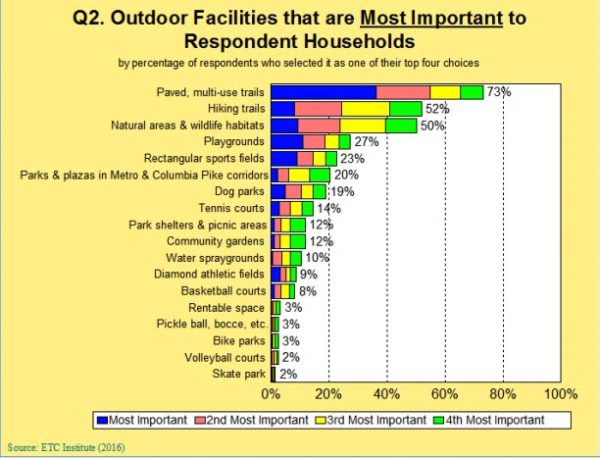 Peter’s Take is a weekly opinion column. The views and opinions expressed in this column are those of the author and do not necessarily reflect the views of ARLnow.com.
Peter’s Take is a weekly opinion column. The views and opinions expressed in this column are those of the author and do not necessarily reflect the views of ARLnow.com.
At its Jan. 8 meeting, the Arlington County Civic Federation (Civ Fed) passed a resolution 66-17-3 regarding the Level of Service (LOS) recommendations for athletic fields contained in the latest draft of the Public Open Spaces Master Plan (“PSMP” or “POPS” plan). (LOS is an acronym for Level of Service.)
Among many other provisions, the Civ Fed’s two-page resolution calls upon the Arlington County government to “withdraw the specific LOS athletic field recommendations” from the POPS plan.
Civ Fed’s January 8 program was designed to stimulate dialogue and improve understanding of this complicated topic. Civ Fed invited the county staff to have an open conversation with its delegates specifically about the lack of supply/demand data and the transparency of the public POPS process. While staff from Arlington’s Department of Parks and Recreation (DPR) were the most knowledgeable people to answer specific methodology questions, the County Manager declined to have DPR staff attend.
Instead, two volunteer resident members of the POPS Advisory Committee spoke on the county’s behalf. They tried to defend DPR’s lack of transparency, while two other residents and proponents of the resolution explained DPR’s own data, which were accessed through a residents’ FOIA request and a six-month resident analysis reviewing diamond fields only. DPR should have defended and explained their process and data, not residents.
Standard industry LOS methodology was not followed; analyses and documents left out
DPR told the County Board, county commissions, stakeholders, and the general public that DPR was following a standard industry methodology called “Population Based LOS” to provide quantitative estimates of levels of service. But, DPR didn’t follow it.
DPR excluded from its calculations and from the public POPS process the abundance of supply/demand field data and analyses which DPR had in its files. But according to DPR’s own consultants’ standard industry methodology statement, these data are necessary to determine Population Based LOS correctly: “Each community determine its own LOS standard based on current supply and demand and future supply/demand projections” POPS_LOS Methodology_171220. This LOS methodology statement was discovered among the documents produced via the FOIA.
DPR’s exclusion is significant. Among the other documents residents obtained under FOIA were DPR’s own analysis showing adequate diamond field facilities through 2035 in contrast to the deficits indicated by the improperly calculated LOS currently in the POPS plan.
Further details explaining how DPR did not follow standard industry methodology are available here.
The importance of the PSMP plan and LOS facility recommendations to long-term planning
The accuracy of LOS for specific categories of facilities — or lack thereof — can be hugely important to subsequent planning decisions.
These specific quantitative LOS recommendations will be used over the next 20 years to decide:
- how acres of public parkland will be used (i.e., more or different sports fields, casual use space, or other features)
- whether to install multi-million-dollar capital improvements (i.e., synthetic turf and/or lights)
These decisions must be considered in a holistic plan developed according to proper standard industry methodology and based on how Arlington residents actually use and need these facilities. Without such a plan, it will not be possible for residents to:
- prioritize which facilities are needed in individual parks
- introduce comprehensive, supply/demand data in any subsequent individual park planning proceeding because such data can only be developed reliably on a county-wide basis, in a county-wide proceeding
Conclusion
Approving the POPS plan while it still contains the erroneous and incomplete quantitative facility (LOS) recommendations will cause the misallocation of tens of millions of tax dollars and substantially harm efforts to meet residents’ needs and priorities in our public spaces.
As the Civ Fed has recognized and supported, the best solution to the present situation is to:
- remove the erroneous LOS recommendations for sports fields before approving the final POPS plan
- commence a new, independent and transparent process to:
- develop new quantitative estimates of county-wide supply/demand for sports fields
- develop new priority systems to maximize the efficient use of our existing fields
- implement an online reservation system to ensure that facility usage is transparent to the public and sports users





